 Chris Korte's New Zealand Genealogy Project
Chris Korte's New Zealand Genealogy Project
Gisborne - Motuhora Railway
About page
This page is about the 78 km Gisborne to Motuhora Railway, built between 1900 and 1917, then removed in 1959-1960. The railway was a vital part of the development of the Matawai district, providing all-weather transport for people and goods. Brief details are provided on the railway construction, utilisation of the line, decline, locomotives used, Newspaper reports from the 1917 opening of the final Motuhora section, and numerous photographs.
Motuhora was renamed Moutohora in 1952. Historical photographs on this page mainly come from the Godber Collection (Alexander Turnbull Library), the Auckland Weekly News (Sir George Grey Special Collections, Auckland Libraries), Steaming to the Sunrise by Chris Wood and Gisborne Photo News.
If you can provide additional information, or corrections, please get in contact (see Info menu).
Construction
| Port of Gisborne | |||
| 0 km | Gisborne opened 26 Jun 1902 | ||
| Palmerston North (1942 - 2012) | |||
| 3.7 km | Park Racecourse | ||
| 5.3 km | Makaraka opened 26 Jun 1902 | ||
| Ngatapa Branch (1915 - 1931) | |||
| 8.4 km | Kings Road (MB) | ||
| 10.9 km | Makauri | ||
| 13.5 km | Waihirere | ||
| 17.3 km | Ormond opened 26 Jun 1902 | ||
| 20.8 km | Kaiteratahi opened 10 Nov 1902 | ||
| 20.9 km | Waipaoa | ||
| Tunnel No 1 - 185 m | |||
| 29.0 km | Te Karaka opened 13 Apr 1905 | ||
| Tunnel No 2 - 258 m | |||
| 32.2 km | Puha opened 3 Jun 1907 | ||
| 37.5 km | Waikohu opened 28 May 1908 | ||
| 41.6 km | Mahaki, ex Waihuka Tunnel Siding | ||
| Tunnel No 3 - 45 m | |||
| Otoko viaduct; 113 m long | |||
| 50.4 km | Otoko opened 6 Apr 1912 | ||
| Rakauroa viaduct | |||
| 60.3 km | Rakauroa opened 2 Nov 1914 | ||
| 66.0 km | Summit; 566m above sea level | ||
| Tunnel No 4 - 90 m | |||
| 70.8 km | Matawai opened 2 Nov 1914 | ||
| 78.5 km | Moutohora (terminus) opened 26 Nov 1917 | ||
| 76 cm gauge private tramway | |||
| Moutohora quarry |
Gisborne to Motuhora Railway showing stations and when station was opened. Distances from Gisborne Station indicated. Large dots indicate stations with buildings.
The Gisborne to Motu Railway was part of the proposed railway from Gisborne to Auckland. The railway had been proposed since 1876, but it was only local agitation in 1897 that began to get the project moving.
The "first sod" of the railway was turned by Sir Joseph Ward (the Minister of Railways) on 14 February 1900. The railway from Gisborne reached Ormond in 1902, Te Karaka in 1905, Waikohu in 1908, Otoko in 1912 and Matawai in 1913. After the railway line reached Matawai in April 1913, the Public Works Department provided limited train services from May 1913 until 30 October 1914 when the station and completed works were handed over to the Railways Department. The final five mile (8 km) section of the railway from Matawai to Motuhora (renamed Moutohora in 1952) was opened on 26 November 1917. The 49 mile (80 km) line cost 627,000 pounds. Extension of the line to the Bay of Plenty never eventuated.
More detailed newspaper reports on the construction of the railway, the opening of the final section in 1917 and facilities at Motuhora are provided below.
The line had four tunnels: one on either side of Te Karaka, one at Mahaki and one on the Gisborne side of Matawai. The bridge over the Waihuka River at Waikohu was a combined rail and road traffic bridge. Viaducts were constructed at Otoko (113m long, 30m above river) and Rakauroa (18m above river).
Utilisation
The rail journey from Matawai to Gisborne took approximately three hours and the return journey four hours. The train typically consisted of a locomotive, two passenger carriages, numerous trucks and a guards van. Two trains up and two trains down per day was the usual between Motuhora and Gisborne for many years. Trains were limited to a maximum speed of 30 mph (50 km/hr), and the maximum load on the Mahaki to Matawai section was 100-170 tons, depending on locomotive.
The line began operating at a profit transporting passengers, cream, sheep, cattle, timber, road metal and general freight. It was reported in 1917 that the five sawmills operating in the district cut 5,740,000 super feet (approx 13,500 cubic meters) the previous year, mainly rimu (59%) and white pine (37%). Most of this timber was transported out of the district by the railway.
A metal quarry near Motuhora provided a large tonnage for the railway, with metal being used for road works in the district and for track ballast on the Gisborne to Wairoa railway. More than 200,000 yards (153,000 m3) of Motuhora metal was used on the Gisborne-Wairoa line, usually with 30 ballast wagons a day leaving Motuhora during construction of the line.
In the 1919-1920 year, 113,503 ordinary passenger journeys and 266 season tickets were recorded, 2,180 head of cattle and 173,945 sheep and pigs were carried, 14,390 tonnes of timber and 16,400 tonnes of metal were transported. Thereafter the passenger and freight traffic tended to decline, with a slight increase again during the second World War when there was petrol rationing.
Between Otoko and the summit 5 km south of Matawai the grade averaged 1 in 35, with some sections 1 in 30. However most of the uphill traffic comprised empty wagons going inland to get primary production, reducing the power that otherwise would have been needed. For the downhill journey the trains were more heavily loaded, requiring more braking power than tractive effort and special rules were imposed to ensure that a safe descent was made.
A siding at Waipaoa served the Kaiteratahi freering works. The works operated from January 1916 until the end of the 1930/1931 killing season and had facilities to process 3500-4000 sheep and 150 cattle per day. The railway brought livestock for slaughter and took frozen carcases to Gisborne for export.
Decline and closure
By 1930 most of the millable timber in the Motu and Matawai districts within economic reach of sawmills had been harvested and the mills began closing down. As the road to Gisborne improved and vehicle ownership became more common, people tended to use private transport in preference to slower rail services. As the road to Gisborne improved, livestock was exported to Gisborne by road in preference to rail because it avoided trans-shipping along the way. Passenger services ceased in January 1945 as NZ Railways Road Services buses offered alternative transport. By 1948 the main items transported were superphosphate fertiliser from Napier via Gisborne to the hill country stations and road metal from Motuhora to Gisborne. Livestock transport was mainly by road in 1948.
Competition from road transport caused the line to start losing money by 1952. Maintenance of the line was suspended in 1952 and the line closed on 14 March 1959. The railway was taken up from Motuhora to Makaraka and station buildings and bridges sold. Demolition of the railway started on 4 April 1959 and lifting of the main track in Motuhora Station yard occurred on 15 April. The demolition gangs reached Makaraka where they stopped work on 15 May 1960.
Following demolition of the railway, the narrow winding metal Matawai to Gisborne road (now State Highway 2) was widened, straightened and tar sealed. Two lane concrete road bridges replaced original single lane timber bridges. Between Otoko and Rakauroa 11.3 km of the new highway realignment used the former railway route. Between Matawai and Motuhora the Motu Road was also realigned using the former railway route in places. The former Matawai railway station is on the realigned Motu road, about 1 km from the Matawai Hotel.
Locomotives
Chris Wood has documented the locomotives used on the Gisborne to Motu Railway in his book Steaming to the Sunrise. All locomotives used on the railway were steam powered using coal for fuel.
In 1902 two D type (2-4-0T) locomotives were shipped to Gisborne for use on the completed Gisborne-Ormond section of the railway. These were rated for 102 tonnes but had insufficient power once the grade increased. A FA class locomotive (0-6-2T) rated at 172 tonnes was introduced in 1909. Increasing traffic on the line meant that more powerful locomotives were required and the first of six WA class locomotives (2-6-2T) arrived in 1910. These locomotives were considered capable hill climbers, rated to haul 204 tonnes.
From 1915, due to heavier loads, two WA locomotives coupled in tandem were used on most trains. Trains departed from Gisborne at 8.00 am and 4.05 pm, and from Matawai at 7.35 am and 3.40 pm, and passed at Te Karaka Station.
The aging WA class locomotives were replaced by WW and BB class locomotives in the 1940s. In 1952 an increase in freight volume with the advent of aerial topdressing required a larger locomotive and following installation of a turning triangle at Motuhora in 1954, AB class locomotives (4-6-2) with a tender were introduced and used until the line closed. AB locomotives, with limited visibility for backing, required the construction of the turning triangle so they could be safely turned around for the return journey to Gisborne.

D Class Locomotive
Used from 1902 on the Motuhora line. Photo: Godber Collection, Alexander Turnbull Library.

FA Class Locomotive.
Used from 1909 on the Motuhora line. Photo: Godber Collection, Alexander Turnbull Library.
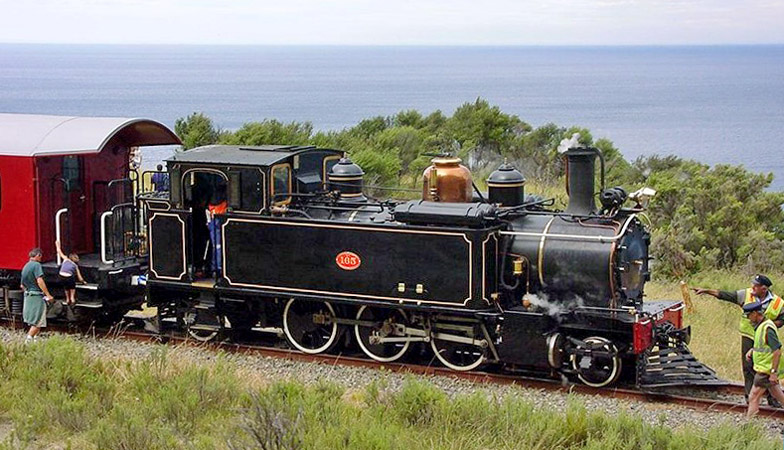
WA Class Locomotive
Used from 1910 on the Motuhora line. Photo of restored WA 165, Gisborne City Vintage Railway.

WW Class Locomotive.
Used from 1940s on the Motuhora line. Photo: Godber Collection, Alexander Turnbull Library.
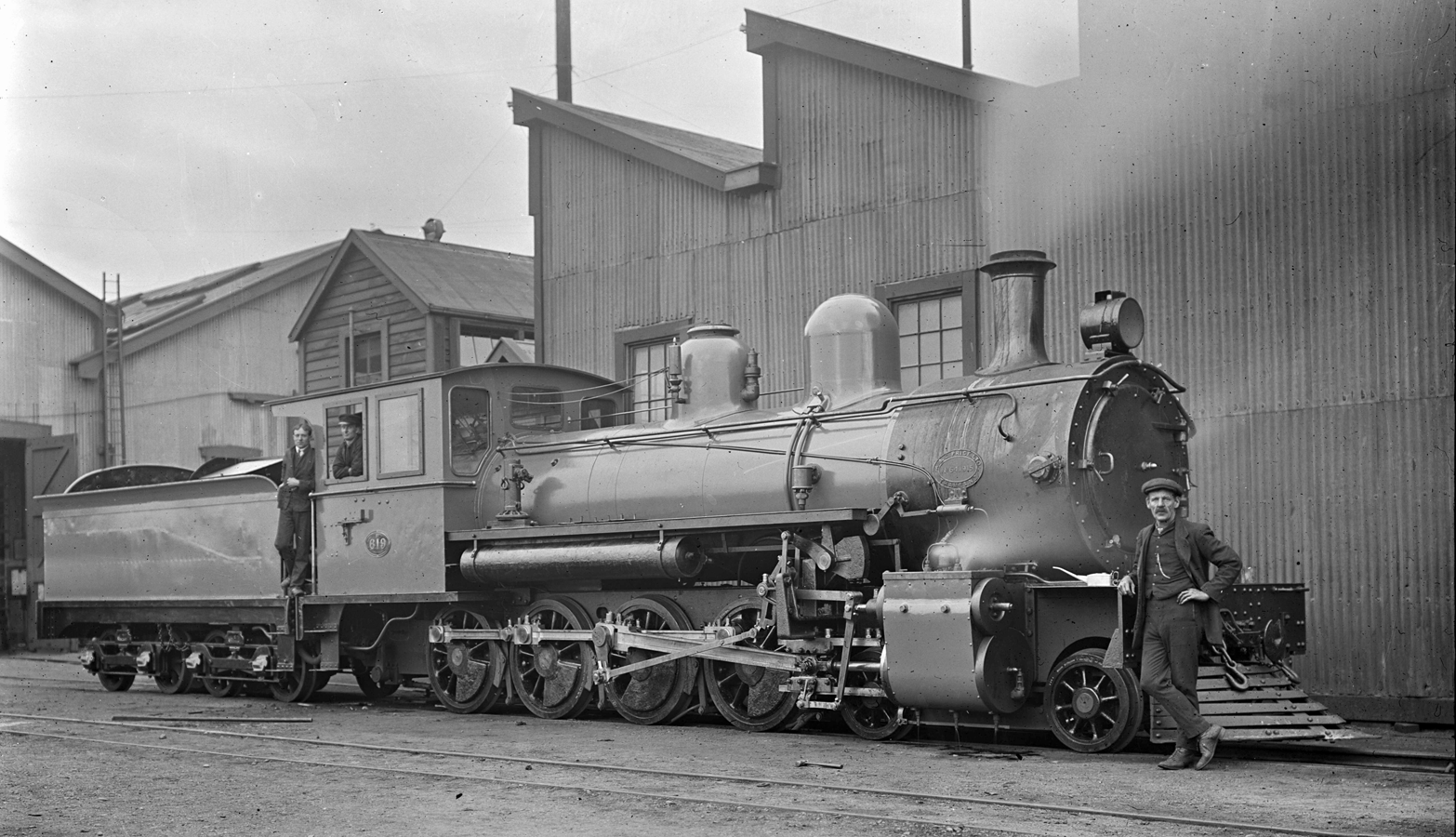
BB Class Locomotive
Used from 1940s on the Motuhora line. Photo: Godber Collection, Alexander Turnbull Library.

AB Class Locomotive.
Used from 1952 on the Motuhora line. Photo: Godber Collection, Alexander Turnbull Library.
Details of locomotives used on the Gisborne-Motuhora railway are given in the following table. The BB and AB class locomotives had tenders for coal and water while earlier locomotives were Tank types with no tender. Maximum loads for Goods Trains on the steep Mahaki to Matawai section are shown in the Load row. Considerably more could be transported on the other sections of the line (400-650 tons depending on locomotive).
| Locomotive Class | D | FA | WA | WW | BB | AB |
|---|---|---|---|---|---|---|
| Configuration | 2-4-0T | 0-6-0T | 2-6-2T | 4-6-4T | 4-8-0 | 4-6-2 |
| Locomotive length (m) | 6.55 | 8.08 | 9.04 | 11.26 | 16.04 | 19.02 |
| Locomotive weight (tonnes) | 14.9 | 30.2 | 37.8 | 52.3 | 44.2 | 52.1 |
| Tender weight (tonnes) | none | none | none | none | 25.9 | 33.9 |
| Fuel capacity (tonnes) | 0.6 | 1.6 | 2.0 | 2.0 | 4.1 | 4.1 |
| Tractive effort (kN) | 21 | 40 | 60 | 75 | 93 | 89 |
| Load (tons) | - | - | 110 | 135 | 170 | 140 |
1917 Motuhora Station Opening
The following reports were published in the Poverty Bay Herald on 26 November 1917 after the final section of the railway from Matawai to Motuhora was officially opened. The reports include the Minister of Agriculture's speech opening the section, history of the project, a description of the Matawai to Motuhora line and of Motuhora.
RAILWAY CONSTRUCTION.
OPENING OF THE LINE TO MOTUHORA
Beautiful weather favored the visitors to Motuhora to-day. The Minister of Agriculture was the concluding speaker.
The Hon. W. D. S. MacDonald apologised for not having been here sooner to open the line, and recalled the fact that Mr Townley had first visited Wellington in connection with the railway in 1876, and after that a permanent Railway League had been set up, which had done a great deal to secure the construction of the line. The speaker went on to refer to the criticism to which the line had been submitted, the railway having been termed, even by people in this district, "A Political Job". After emphasising the persistent agitation on the part of Sir James Carroll, he went on to say that a few years ago they had as many as 500 men employed on construction in work, but to-day many of these fellows were away at the war. Whilst advocating the importance of further construction, the speaker said that whatever Government was in office they had to remember the demands of other districts in the Dominion, and he reminded them that there had not always been, the general prosperity in the Dominion that there was to-day. He mentioned that when he first came to the Motu district to settle he had to pack things from Te Karaka. Since 1900 there had been no less than five Governments wielding the destinies of New Zealand, and as far as men and money were concerned, they had done their best to carry the line on, and had made a strong endeavor to give the district a fair hearing. The sum of £682,000 had been spent on the line, of which £550,000 had been spent in the last ten years, and of that there had been three years of war. He referred to the great difficulties in carrying on railway construction at the present time, and pointed out that it had taken 17 years to build 49 miles of line. A considerable amount of work had been done on the northern section in the Bay of Plenty, making about 100 miles of railway between Gisborne and Auckland that had been completed during 17 years, and leaving about 98 miles still to complete. Whatever Government was in office, he recognised it would have to make provision in future to carry the line on at full speed. A large number of men were away fighting at the war, and when they returned they would be wanted to carry on productive work in New Zealand. At the present time there were about 100,000 men at the war and in camp. Speaking of the difficulties of the last three years, he said that the contractor had to dismantle other bridges to complete the one near the station. So far as possible the best was being done with the depleted state of the labor market. He said he was confident that the Minister of Public Works and his staff would carry out the location of the route of the line, and thought the railway might not proceed far past Motu for some time. Still, the work on the Bay of Plenty side was going on, and a good deal of work had also been carried out on the Gisborne-Napier section. During the last three years of war, Mr Armstrong had spent £300,000 on road and railway construction, and a great deal had been done with the money and labor available. It was the lack of money and men that was detaining the Government at the present time.
After dealing with other local matters, the Minister formally declared tho line opened, and called for cheers for its success.
Mr Armstrong replied, thanking the speakers on behalf of himself and others, and Sir James Carroll said a tribute to the early settlers, mentioning especially the name of Mr Whinray.
A deputation from the Matawai settlers respecting local matters was received.
With regard to the request for a stationmaster at Matawai, he promised that he would do his best to have their request compiled with. The request for a school would be brought under tho notice of the Minister of Education (Mr J. A. Hanan).
The special train left at 3 p.m.
Source: Poverty Bay Herald, 26 November 1917, Page 4.
GISBORNE TO MOTUHORA.
OPENING OF NEW RAILWAY SECTION.
COMPLETION OF ORIGINAL PROJECT.
HISTORY OF CONSTRUCTION.
The official opening of the railway to Motuhora to-day not only marks the completion of railway construction, on the Gisborne-Motu railway, but the consummation of the first and, to this distinct, the most important portion of the original railway project — the Gisborne-Rotorua railway. The dream of some of our early residents, the pioneers of Gisborne of to-day — the building of a railway to the Motu — has been accomplished.
The "first sod" of the Gisborne railway was turned by Sir Joseph Ward (the Minister of Railways) on February 14, 1900, and many will doubtless retain a vivid recollection of the drenching rain which immediately followed that memorable function — a red-letter day in Gisborne's history.
CRITICISM AND PESSIMISM.
Quite a chapter could be written of the incidents associated with the commencement of railway construction in this district, the controversy respecting the station site, and the pessimism expressed respecting its future progress. Croakers who characterised the whole thing as a political move, and who averred it would "never get beyond Makaraka cemetery," have passed away. Opposition was not confined to Gisborne alone, and the writer recalls tho derisive reception that was sometimes accorded in the House of Representatives to the member for Waiapu for the very mention of the Gisborne railway, which was jocularly referred to as Sir Jas. Carroll's "pet" scheme. That attitude has now happily passed into oblivion, and the practical results of the operation of even the Gisborne-Te Karaka section provided in itself a complete and effective answer to that section of the House whose opinions were voiced by the late Sir. Wm. Russell when he declared to Parliament that "the Gisborne railway will never pay axle-grease." We have been able to point with pride to the fact that compared with other similar lines, it is one of the best-paying railways in the Dominion. Now that it is directly tapping the timber area and opening up a milling industry, the returns should considerably improve, more especially when the country reverts back to normal conditions after the war and a levelling up of the tariff places our timber export trade on a similar footing to that of other districts — or, better still when a through line provides direct facilities for the development of extensive trade between Gisborne and the Bay of Plenty. Apart from the possibilities in sheep and cattle traffic, the railway will open up a big field for commercial enterprise.
A NATIONAL UNDERTAKING.
Gisborne's sphere of mercantile operations does not end at Motu. Everyone who has the welfare of our district at heart, everyone who realises the great potentialities of Gisborne and its rich and fertile hinterland, must deeply regret the conditions that have brought about a cessation of railway construction on the East Coast. At the same time, it is gratifying to realise, especially at this juncture, that the Gisborne railway — the visionary project of by-gone days — has emerged from its parish and political stagehand is now recognised as an essential link in a national undertaking of first importance to the Dominion, viz., the East Coast Main Trunk line. Some day it will connect Gisborne by rail with Napier on the south, and Auckland on the north. On the occasion of a visit to Gisborne in May 1915, the present Prime Minister, the Hon. W. F. Massey, expressed the hope that he would live to see the day when he would board a train at Napier and travel right through to Auckland, via Gisborne. Seeing that it has taken 5½ years to build the present section from Matawai to Motuhora (five miles), Mr Massey will probably require to live to the age of Methuselah at the present rate of progress.
EARLY CHAMPIONS.
Space will not permit in this article to detail the history of the early railway agitation, the persistent advocation of the work by the late 'Mr David Whyte, introduced to Lord Ranfurly as "the father of the railway," or of another equally consistent advocate, the late Mr Jas. Whinray, who championed the importance of the Motu timber, and who poured out his strongest condemnation on the national sacrilege respecting its destruction. Happily, Mr John Townley has been spared to see the completion of the railway which he and others associated with him championed in season and out of season, whilst Sir Jas. Carroll, who was instrumental in inducing the late Hon. R. J. Seddon to consent to the authorisation of the line, has also been spared to see his "pet" scheme carried into effect.
INITIAL EXPLORATION.
It is interesting to recall that the late Mr James Stewart conducted the reconnaissance survey for the proposed Gisborne-Rotorua and Gisborne-Opotiki railways. The former route lay through the Urewera Country and Wharekopae to Gisborne, and in his report, dated 1899, Mr Stewart states: "Comparing the amount of settled country traversed by the two routes, the existing traffic, and the possibilities of future settlement, there seems, to be a preponderance in fayor of the Opotiki route on commercial and social grounds, as there is in engineering." Detailing his exploration through Motu, he remarks that he was "greatly indebted to the hospitality and great kindness of the only two settlers in the bush for accommodation." Incidentally, it should be mentioned, Mr Stewart selected the Waikohu valley, or the locality of the old Motu "front" road, via Poututu, as tihe route for making the ascent to Motu.
PROGRESS OF THE WORK.
Railway construction was initiated under the supervision of Mr John Stewart, and the first sod, as mentioned previously, was turned by the Hon. (now Sir) J. G. Ward on February 14, 1900. Formation had extended a little beyond Ormond when Mr C. E. Armstrong was transferred from the Main Trunk to take charge of the work. One of his first duties was the investigation more closely of the question of route, and it was upon his recommendation that the present line via Otoko and Rakauroa was adopted. As district engineer for the Public Works Department at Gisborne, Mr Armstrong has had the satisfaction of seeing the "handing over" at Motuhora to-day of the work upon which he has for so many years devoted considerable energy and ability.
It was a red-letter day that marked the opening of the railway to Ormond, and again to Te Karaka. The Waikohu section (23 miles) was opened on May 25, 1908, and the Otoko section on April 6, 1912. The handing over of the eight miles of railway to Otoko, it is worthy to recall, constituted the Hon. W. D. S. MacDonald's maiden function as Minister of Public Works in the Mackenzie Government. The Railway Department's service was extended a further 12¾ miles to Matawai on October 30, 1914, without any formal ceremony. It was fitting that to-day the Hon. W. D. S. MacDonald, who has championed the more speedy prosecution of the railway since his entry into Parliament, should, as a member of the National Government and member for the electorate through which the line passes, have the honor of declaring the last section officially open.
Considerable delay has been occasioned over the completion of the five-mile section opened to-day. Work on this portion of the line was actually in progress to a point a mile beyond Matawai as far back as April, 1912, and whilst the war may to some extent have been a contributing cause to the exasperating policy of inaction of the last two years, it is clear, on the face of it, and to all who have taken any special interest in the railway, that it was not the only cause of the snail-like progress of five miles in 5½ years.
According to the announcement made by the Hon. W. D. S. MacDonald today, the cost of the Motuhora section has been £85,000, bringing up the total cost of the line Gisborne to Motuhora (49 miles) to £627,000.
A sketch of the railway history would not be complete without some reference to the Hon. Roderick McKenzie, who was the first (and apart from Mr MacDonald) the only Minister of Public Works who has been over the route from Gisborne to Opotiki. Mr McKenzie evinced great interest in this section of the East Coast Main Trunk, and to make himself familiar with the undertaking went over the route on several occasions, and it was due to this that the work at that stage was pushed on with more energy. As Minister of Public Works he had golden opinions of the East Coast, and to the writer he once expressed the hope of seeing the trains between Gisborne and Opotiki operated with current from Waikaremoana.
"BATTLE OF THE ROUTES."
Many interesting questions have cropped up during the course of construction, not the least of which has been the "battle of the routes" for the difficult section between Motu and Opotiki. Exploration has been conducted during recent years over three routes, Pakihi. Whitikau, and Waioeka. The actual distance between Motu and Opotiki, as the crow flies, is only 23 miles, but considerable engineering difficulty presents itself in the location of a suitable route. Situated at an altitude of 1600 feet above sea level, on the backbone of the East Coast, the descent from Motu on the Opotiki side is exceedingly precipitous, and whilst as far as can be gathered the Pakihi route is at present favored by the Department's engineering experts, further investigation is considered necessary before any definite route is decided upon. The approximate railway distance between Motu and Opotiki is 40 miles. Motuhora marks the point where the main controversy starts — Pakihi v. Whitikau — and it has consequently been chosen as the railhead for the time being. Meanwhile, the accepted policy is to proceed with construction on the easier and less expensive sections between Tauranga and Opotiki, leaving Motu and Opotiki to be linked up at a later date.
The selection of Motuhora as the terminus has been the subject of a great deal of criticism from time to time, more especially from the residents of Motu, who naturally desired the line extended to the township. A promise was in fact, extracted by tho Hon. Mr MacDonald from the late Government to build the line into Motu township, a distance of approximately 2½ miles. A certain amount of work was actually carried out, whilst the station site was selected adjacent to the Motu bridge. The extension, however, was subsequently cancelled as a result of a protest from the Auckland Railway League against the expenditure on what they termed a "branch" line. This, however, was not strictly the case, as the adoption of the Whitikau route would have entailed the extension through the Motu township.
Whilst the question of route may be accepted as a legitimate excuse for the closing down on construction, the completion of the trial surveys between Motu and Opotiki should not be lost sight of by the Gisborne Railway League, and all who wish to see the completion of this important national undertaking and the linking up of Gisborne with the railway facilities of other centres, an event which, in the memorable words uttered by the late Hon. Dr. McNab on the occasion of his visit to Motu some years ago, "would add another province to the Dominion."
THE NEW SECTION.
DESCRIPTION OF THE LINE
The new section which is opened today marks the extension of the railway from Matawai (44 miles from Gisborne) to the new rail-head at Motuhora (49 miles). The section is thus five miles in length, and ending at Motuhora station marks the present terminus of railway construction.
CONSTRUCTION FEATURES.
Leaving the Matawai station and its fine spacious yards located on the terrace above the river flats, the line proceeds in a northerly direction, passing the scene of the old Main Camp, which in its palmy days was occupied by several hundred residents. The first work of any size is a big bank at 44½ miles. Here a stream has been filled in, and the water-course is provided for by a circular reinforced culvert. Beyond this the work is of a light nature until passing the 45-mile peg, when a series of heavy rock cuttings is encountered. There are also two large gullies that have been filled in with material from the cuttings. A considerable quantity of rock from these cuttings was used as spawls in putting down the road bed along Neill road. Neill road, it should be mentioned, which extends from Matawai to Motu, along the line of formation, was used for the conveyance of material during the course of construction. Although these spawls made a solid foundation for carrying the weight of traffic, motor and other vehicles today are now finding the surface rather bumpy. A blinding of river shingle, however, would doubtless provide an excellent road on this specially well-laid foundation. The section of road running through the bush was particularly wet and swampy, and this method of putting down heavy spawls had to be adopted in order to carry the heavy carting.
MEMORIAL OF A LIFE'S WORK.
The line strikes the hill cuttings at a point opposite the former site of Mr. F. Hall's old mill. The bush at this end has now been cut out, and the mill has recently been moved on into the standing bush near Motuhora. The railway cuttings are about 50ft above the road, and incidentally it might be mentioned that it is at this point the railway strikes the Motu river for the first time.
A most extensive piece of banking has been effected at the larger of the two creeks. What was formerly a most picturesque road crossing of a beautifully clear stream that poured into the Motu river at this spot has been completely changed. Indeed, the landscape presents a transformation. An enormous bank, fully 50ft above the roadway, has been thrown across the creek, and the water from the valley at the back emerges through a massive circular culvert. Built of reinforced concrete, the culvert has been extended an additional width to accommodate the road traffic on the lower level.
To all who have been associated with the progress of the construction of the Gisborne-Motu railway, this big and imposing piece of work will stand for ever as a monument to the services of the overseer so long connected with the work, the late Mr. J. J. Marshall. An officer of the P.W.D. for many years, the late Mr. Marshall was regarded as a very careful overseer, and a man who would accept nothing but the best of work. The job in question formed the scene of his last years of service, and on this, the occasion of the official opening, it is only fitting that some testimony should be paid to his memory.
A TRANSFORMATION.
The scene of transformation that has been effected, consequent upon the advent of the iron horse. The early pioneers of Motu only with difficulty will recognise Scott's creek as the scene of an exciting tragedy in the early days, whilst Dead Man's whare, a slab building located but a few chains distant, has only recently fallen into decay and practically disappeared. The clear-running ford, with its fine shingle bottom, the picturesque scrub, and groups of pungas have given place to the substantial business-like embankment that carries the railway across the mouth of this memorable valley.
QUARRYING OPERATIONS.
A mile and a-half beyond Matawai the line passes the P.W.D. quarry. Operations have been conducted here for some years, an extensive quarry having been opened during the formation of the line. At that time it was the only point showing what was regarded as suitable rock material for ballast. Three small drives were put into the hill, approximately 60ft in depth. The rock improved as the drives proceeded. On tests being conducted and the rock found suitable for ballast, it was decided to put in a charge in order to dislodge the stone, thus facilitating the future working of the quarry. At the ends of the drives cross-cuts were made and into each two tons of powder were placed, or a little over six tons in all. This large charge was fired by electricity, and the result was regarded as most successful. There was another "Messines" blow up - but on a smaller scale — the hillside rocked violently. The rock was not only shaken by the charge, but was broken into sizes that were readily worked. A crushing plant was subsequently installed, and a considerable quantity of stone has been taken out for ballast. In fact, a great part of the track from the Matawai tunnel as far as Motuhora station, including the station yard, was ballasted with material from this quarry, which obviated a considerable amount of haulage up the steep grade from Puha.
About 46¾ miles distant the line enters the bush section, and, incidentally, it might be remarked, this is the first of the maiden bush of any extent encountered on the long run up from Gisborne.
THE MILLING INDUSTRY.
Standing bush extends from 46¾ miles right through to Motuhora station, and the station-yard at the railhead itself was dense standing bush and very swampy. After leaving the heavy cuts and banks at 46¼ miles the formation becomes lighter and consists of cuttings and embankments following along the natural terrace, which is intersected by small watercourses.
The railway skirts close to the Motu river in places, and running along in the train some picturesque glimpses of the river as it winds through the overhanging bush are obtained. In places there is only sufficient room between the railway and the river. The combination of bush and mountain scenery is very fine, far surpassing anything of the kind remaining in any other part of the district. Unfortunately the march of progress and settlement will not allow of these charming conditions remaining much longer. Already milling operation have destroyed some of the most charming spots, and it will certainly be a matter of very great regret if some arrangements cannot be made for preserving a portion of this picturesque scenery. A wide avenue has been cut for the railway through the standing bush on the river flats which open out as Motuhora is approached. Already the whistle of the log-haulers resounds through the valley, and the magnificent rimu bush which has been preserved from the axe and fire stick of the settler will form the scene of milling industry for some years to come. The Motu timber, apart from its enhanced value, in consequence of the cutting out of other milling areas elsewhere, has come to be recognised as some of the finest in the Dominion, particularly the rimu, whilst Australia provides an unlimited market for the white pine. At the present time there are four mills operating in the locality. Mr McLeod's at Matawai, Mr Quirk's adjoining the railhead, Mr Geo. Smith's on the old "front" road a couple of miles distant, and Mr F. Hall's new mill recently re-erected in the heart of the standing bush a few chains away from the Motuhora station.
TEMPORARY SERVICES.
To return to the railway. The next object of interest reached is the temporary siding (47¾ miles) that served originally as a loading place from Mr Quirk's mill. The policy of the successive Ministers of the Public Works Department has been one of consideration to the milling industry and the settlers generally, in permitting the installation of temporary sidings and the providing of temporary services long before construction had reached the stage when the iron way could be taken over and operated under the more cast iron regulations of the Railway Department. This has been a feature of the Public Works Department administration, on this line, and generally speaking no sooner have the rails been down and the tracks reasonably safe than it has been made available. Settlers should have occasion to remember with, gratitude the temporary service run by the Public Works Department to Otoko, to Rakauroa, and afterwards to Matawai. The same eulogy, perhaps, cannot be paid in respect of the new section to Motuhora, which, owing to the paucity of the votes provided, seems to have been an age in building. Still, at the same time, the arrangements under which timber has been railed in over the uncompleted line have been of distinct benefit to the milling industry. Although temporary train services have been carried out by the Public Works Department for many years past, happily one is able to record there has never been a serious accident in connection with the transportation of passengers. Occasionally the ballast train services have assumed large proportions, there being employed as many as three engines on one section at a time.
"Quirk's siding," as it was termed, has been out of commission for some months past, in consequence of the extension of the rails into Motuhora station. These temporary sidings, whilst inexpensive, enable a considerable saving in haulage on the country roads to be effected. Heavy cartage on the Matawai road, for instance, was soon proved to be disastrous.
The Motu river is spanned at 48½ miles, the bridge being of the usual substantial type, and in this case built with ironbark trusses and steel lower cords. It has a total length of 168 ft, including one 80ft span. The bridge is 28ft above, the ordinary water level, thus placing it well clear of all floods. It has now been completed, and in use for ballast service some months. The structure was built by Mr J. A. Nicol, who experienced considerable difficulty in obtaining steel owing to the war.
Owing to the railway line having to be carried at a higher elevation than the road to keep it clear of all floods, it has been necessary to effect an extensive deviation of Neill road. Floods in the Motu river are considerable at times and the bridge approaches on either side are carried on long embankments.
MOTUHORA.
Immediately after crossing the Motu river the line approaches the Motuhora station, located on the expansive river terrace within a mile or two of the foot of the Motuhora mountain, from which the name has been derived. Motuhora already presents quite imposing dimensions, and is doubtless the forerunner of much future settlement. The station buildings are quite of an imposing nature — almost as large as the Gisborne station itself. Nearby there is a stationmaster's house and four cottages, which together with the adjacent mill (Quirk's) and mill cottages, store, etc., go to make up a pretensive township.
STATION FACILITIES.
A 6000-gallon vat has been erected to provide water supply storage for the railway, the water being pumped by oil engine from the Motu river, about 10 chains distant.
An outstanding feature of the station facilities is the lengthy verandah, a provision, that has been necessitated in consequence of the climatic conditions.
The main station building is about 100 feet in length and, as will be seen from, the following dimensions, is quite a large structure: Ladies' waiting-room 16ft x 16ft, public lobby 16ft x 16ft, station-master's office 18ft x 16ft, parcels and main office 20ft x 16ft (with 16ft counter), lamp room 16ft x 10ft, also telegraph and tablet room 10ft x 7ft. The verandah extends over either end of the station building, and has a total length of 192 ft, while the platform extent is 300 ft in length, with a substantial concrete kerbing that adds greatly to the appearance of the station. The other buildings include: Goods shed 40ft x 30ft, loading bank, stockyards, and facilities for holding stock, engine shed (with pit and water supply), coal store, and three movable platelayers' huts.
The residences provided for the station staff are of a commodious and up-to-date type. The station-master's house comprises six rooms, with bathroom, scullery, etc., whilst the others are of five rooms, with similar conveniences. The joinery throughout the station buildings was all manufactured at the P.W.D. workshop at Gisborne, whilst the contract for the erection of the buildings has been carried out by Messrs Haisman and Booth, who have turned out a most creditable job, having spared no effort to give the Department every satisfaction. In order to economise the station buildings have all been roofed with R.O.K. roofing.
A BUSY STATION.
Apart from being the terminus for some years to come, Motuhora will be the busiest station out of Gisborne. The milling industry alone will make it a scene of industry for many years, whilst the Motuhora quarry, only a few miles distant, is being connected by tram-line and will add its quota to the traffic. Quirk s mill, as originally mentioned, immediately adjoins the station, and Mr. Hall's re-erected mill is only a short distance up the river, and this, too, is being connected by tram-line. Back across the Motu river on the old road there is Mr. Smith's mill, and in the course of time further extensive milling plant will no doubt be installed by Mr. Hall in his large and valuable bush fronting Neill road.
The locality in which the station stands was originally known as Kowhai road, a name taken from the road that extended into Mr. Orr's property, and that of Mr. Little's, and down this road the tram-line will run from the Motuhora quarry.
The railway ends at a point 49 miles 8 chains from Gisborne, and an extension of about 2½ miles across the intervening flat would land it in the Motu township. Motuhora station is placed at an altitude of 1600 ft, which is a good deal lower than Matawai (1757 ft). The actual highest point between Gisborne and Opotiki is the summit (1854 ft) at Mr. Abbotsford Smith's between Rakauroa and Matawai.
Motuhora station is three miles distant by road from Motu township, there being a metalled road all the way, a substantial traffic bridge being erected across the Motu river near the terminus.
Mr. J. J. Wilson, assistant engineer, has been in charge of construction work, under the supervision of Mr. C. E. Armstrong, district engineer. Mr. Wilson is being transferred to Kaikohe, Bay of Islands.
Source: Poverty Bay Herald, 26 November 1917, Page 5.
Notes: P.W.D. - Public Works Department
Dreadnought Bridge
The "Dreadnought" bridge was located a mile and a half (2 km) from the No 3 Tunnel (44 km from the Gisborne Station), between the Tunnel and the Otoko viaduct. The bridge was given its name by workmen because of its central pier being shaped somewhat after a warship's bow according to the Poverty Bay Herald (31 Jan 1910 page 5). Great difficulty was experienced in the construction of this bridge, a coffer dam having to be sunk in mid-stream for the building up of the central pier. A photo below shows the bridge in 1910 when this section of the railway was being laid. The other photo of the bridge from 1950 shows the bridge deck after subsidence destroyed track and the bridge, stoping rail services beyond Waikohu for several months until the track was reinstated. The bridge was replaced with a culvert.

Dreadnought Bridge, 1910
Photo: Auckland Weekly News, Sir George Grey Special Collections, Auckland Libraries.
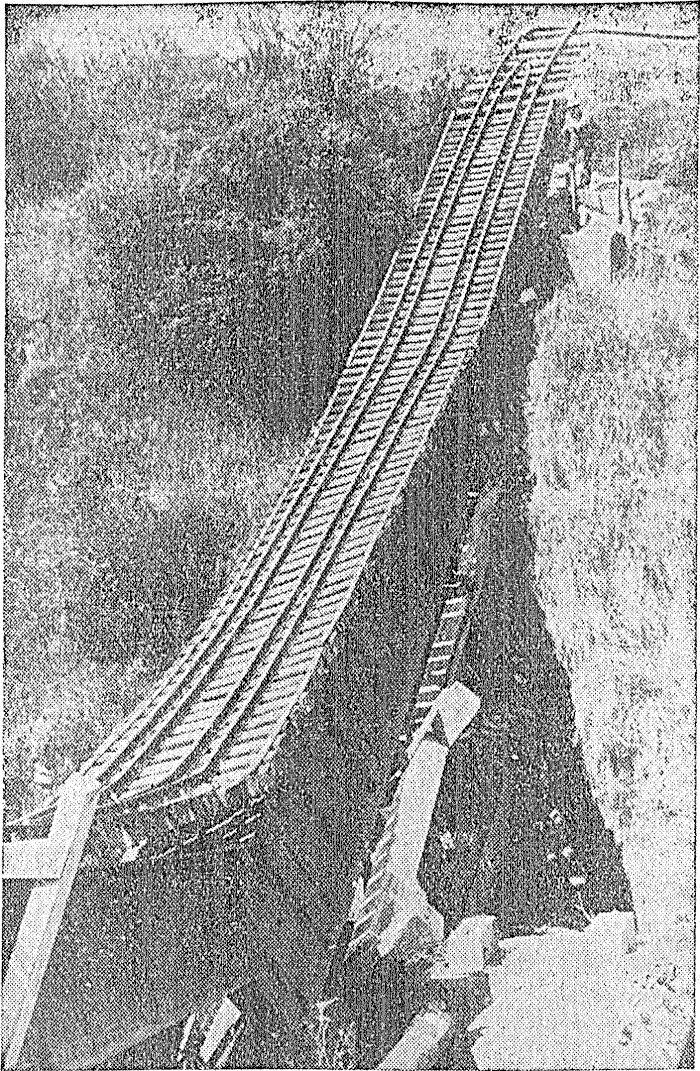
Dreadnought Bridge, 1950.
Wreckage of the Dreadnought Bridge, between Mahaki and Otoko, resulting from a large-scale subsidence which carried away part of the railway, and which is expected to hold up rail traffic for some months. Photo: Gisborne Herald, 9 Nov 1950.
Bridge Seriously Damaged In Hillside Collapse
Very serious damage has been caused to the Dreadnought railway bridge, half-way on the Otoko Hill section between Mahaki and Otoko and about opposite to the homestead of Mr. W. Honey as the result of a huge slip at be weekend.
According to travellers, a section of 150 to 200 ft. of the bridge piers and superstructure has been carried away by a very large fall of debris from the hillside above.
The slumping effect of the movement has shoved pieces of the bridge to a crazy angle and has left on the old site of the bridge a jumble of clay, soil and rocks in which the location of new piers presents at a glance a considerable engineering task.
Concern Expressed
Keen concern is expressed by hill country residents lest the extent of the damage done at the Dreadnought bridge site and the consequent high expense involved in reconstruction there may provide the Railways Department with an argument for discontinuing the railway service between Gisborne and Matawai.
The bridge is a one-span structure of steel girders mounted on concrete piers. A discharge of water from the hill above the bridge was provided for by the construction of a water schute, but while this structure is believed to be intact it has not prevented the seepage of water into the sub structure and the consequent collapse of the hillside.
The line has decreased in importance in recent years, especially since the transfer of passenger traffic after the purchase of the Musgrave Motor Service by the Railways Department: but its value to the settlers in the high country in handling fertiliser and other heavy-freight commodities is inestimable.
Source: Gisborne Herald, 25 October 1950, Page 8.
Photos
Links to photo sections:
Gisborne Station

Gisborne Railway Station, 1901
Auckland Weekly News 14 November 1901
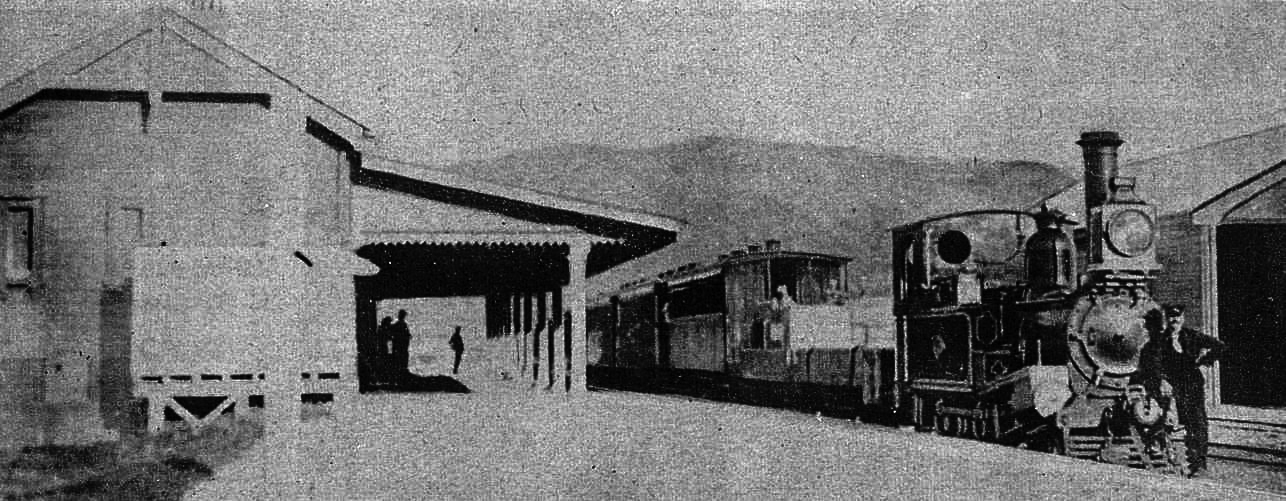
Gisborne Railway Station, 1903
Train ready to leave for Kaiteratahi
Gisborne Photo News

Gisborne Railway Station and yard, about 1927.
Photo: Godber Collection, Alexander Turnbull Library.

Last Motuhora freight train from Gisborne Railway Station, 1959
Gisborne Photo News
Te Karaka Station

Te Karaka Station in 1909
Auckland Weekly News, 08 April 1909

WA loco and train at Te Karaka Station, 1920s.
Photo: Godber Collection, Alexander Turnbull Library.

Te Karaka Station 1959, with locomotive AB702.
Photo Bob Hepburn, NZ Model Railway Journal, June 2003.
Puha Station

Puha Station, with wagon loads of wool for transport to Gisborne, 1909
From Auckland Weekly News, 2 December 1909
Waikohu Station

Waikohu Railway Station and combined road and railway bridge over the Waikohu River, 1909.
The station has a goods shed (left), station building and platform (right of line) and three cottages (right).
Auckland Weekly News, September 1909
Bridge and Tunnel, Waihuka

Number 3 Tunnel and adjacent bridge, 1910.
The Gisborne-Matawai road is above the tunnel.
Auckland Weekly News, March 1910.

Mahaki Bridge over the Waihuka River, with East Coast Rail Tour special, locomotive AB831, 1953.
Photo taken from Gisborne-Matawai road above the tunnel.
Photo R. Hepburn, The N.Z. Railway Observer, April-June 1959.
Otoko Viaduct
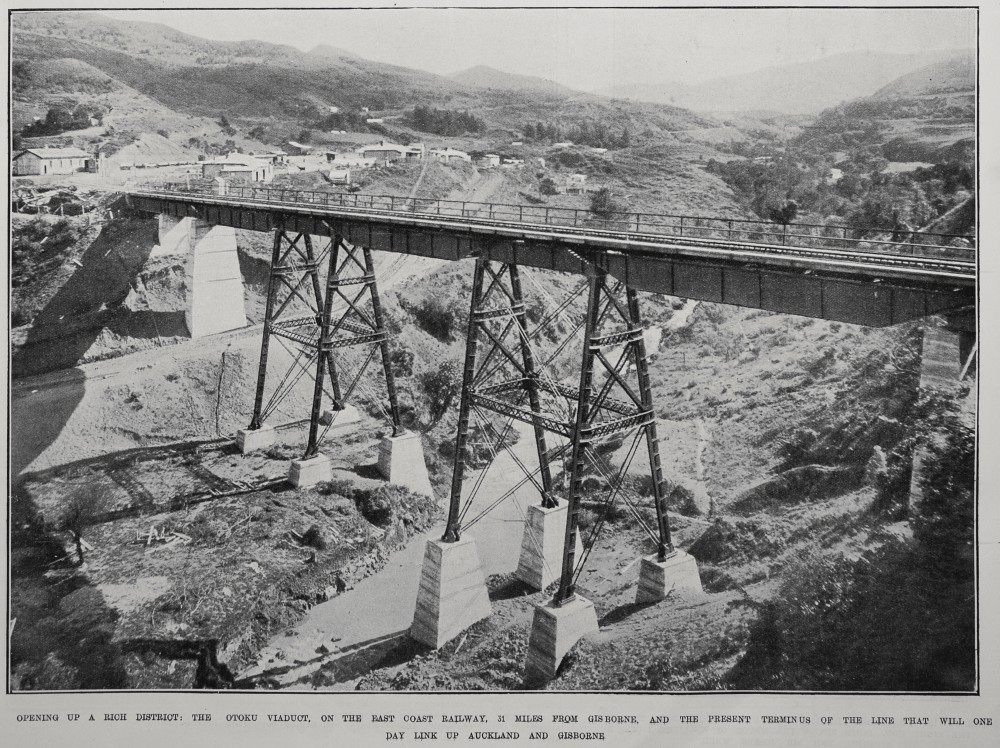
Otoko Railway Viaduct over the Waihuka River and the Gisborne-Matawai Road.
Auckland Weekly News, June 1912

Otoko Railway Viaduct over the Waihuka River and the Gisborne-Matawai Road.
Note the poor condition of the road!
Auckland Weekly News, 16 May 1912

Train on Otoko Viaduct, 1959.
Photo from Gisborne Photo News
Otoko Station

Last train to Motuhora in March 1959, pulling into Otoko Station and leaving the Viaduct.
Photo from Tairawhiti Museum

Train to Motuhora pulling into Otoko Station in 1959, with truck waiting at the level crossing.
Photo from New Zealand 1950s steam in colour

Train to Motuhora on the line north of Otoko in 1959.
Photo taken from previous rail over bridge north of Otoko.
Photo from New Zealand 1950s steam in colour
Rakauroa Viaduct

Train on Rakauroa Viaduct 1955.
Photo from Gisborne Photo News
Matawai Station

Matawai railway yard in 1913.
Newly built cottages beside yard for railway workers.
Auckland Weekly News, 2 October 1913

BB169 locomotive at Matawai Station with a goods train in the 1950s.
Goods shed behind train with covered siding, passenger platform and station building (right). A further image of the station building is shown in Deconstruction photos.
Photo from Paul Mahoney Collection.

Train leaving Matawai Station for Gisborne in 1954.
Photo from Gisborne Photo News
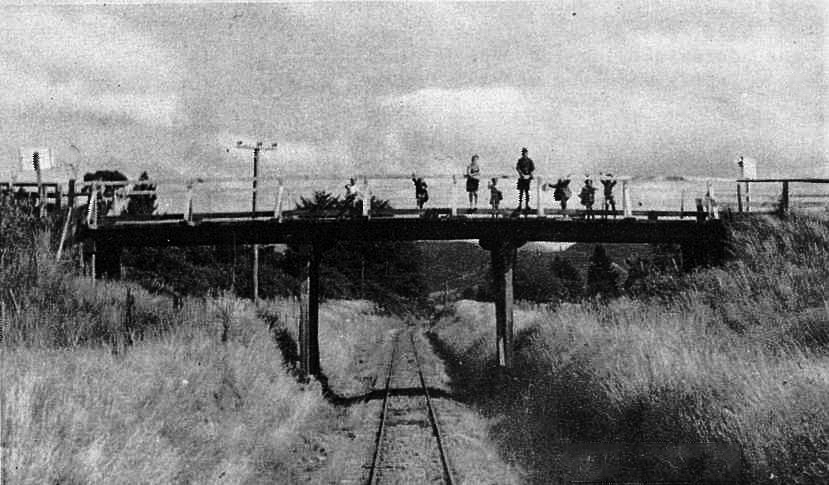
Railway over bridge on Motu Road between Matawai Post Office and Railway Station.
Photo from Gisborne Photo News
Motuhora Station
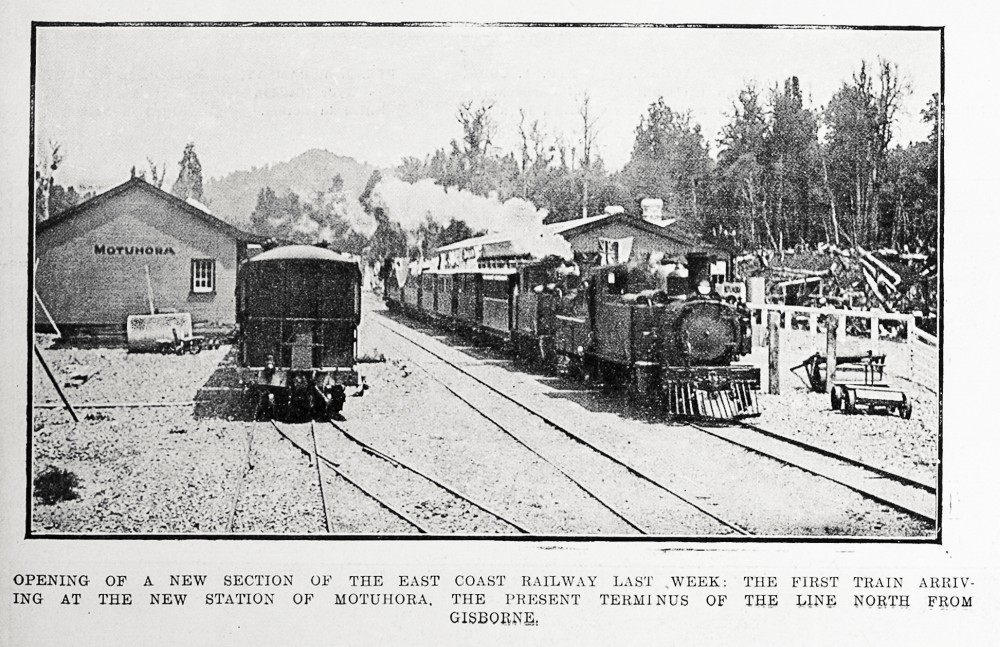

Motuhora Station and railway yard
Auckland Weekly News, 6 December 1917.

AB 753 prepares to depart Motuhora Station on the morning of 18 Jan 1954.
Photo by Bob Hepburn.
Deconstruction 1959-1960
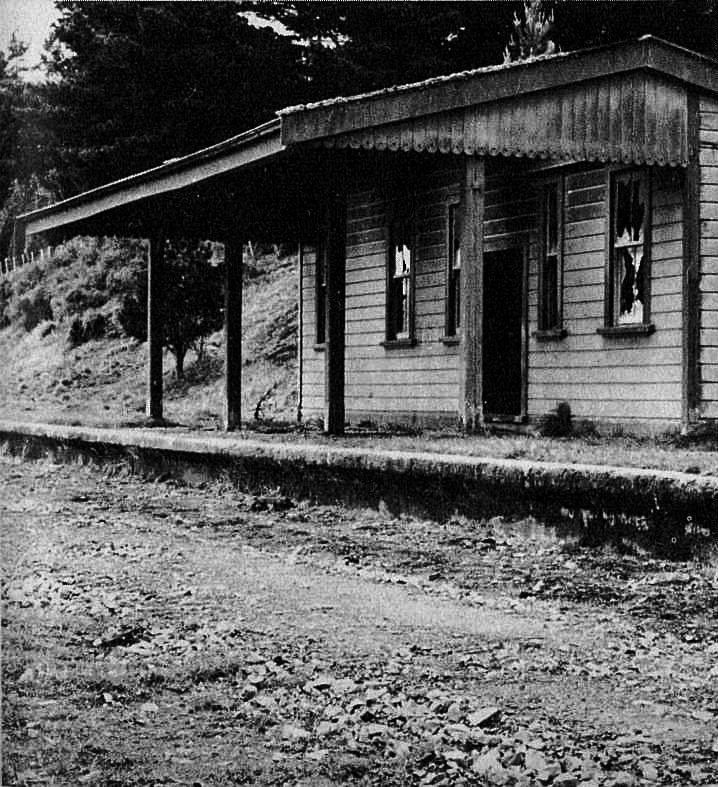
Matawai Station building after railway line removed in 1959
The building was later removed leaving just the platform, and subsequently the Motu Road was built through the station yard. The Goods Shed was also sold and removed.
Photo Gisborne Photo News

A crane dismantling the Rakauroa Viaduct in 1959
The Tahora Road and Waikohu River passed under the viaduct.
Photo Gisborne Photo News

Workmen salvage steel plate from Otoko Viaduct in 1960
Photo Gisborne Photo News, 25 February 1960

Otoko after removal of the railway
Shows site of former level crossing and viaduct remains beyond the house far right.
Photo Gisborne Photo News, 1960
Remnants of the Railway

Bridge originally over Motu River at Motuhora.
The bridge was purchased to move to a Matawai farm, but never got moved. The river has moved since.
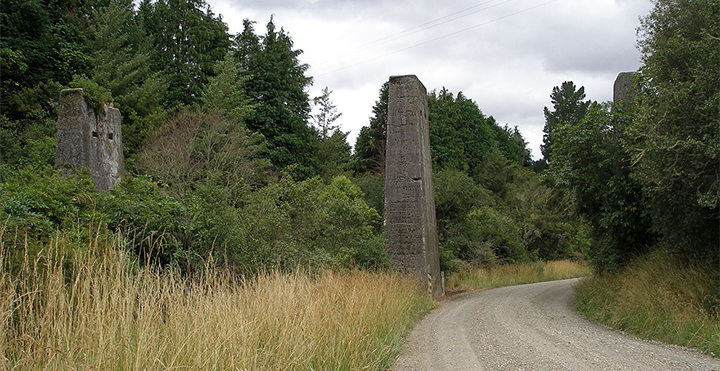
Remains of Rakauroa Viaduct in 2015

Remains of Otoko Viaduct in 2015
The old Matawai-Gisborne road going up to Otoko is on the far side of the Viaduct.

Tunnel No 3 in 2015.
Now the start of the Otoko Walkway, which follows 6.9 km of the old railway route to Otoko.

Site of Waikohu Station.
The Goods Shed now used as a farm shed.
Page last updated 4 Nov 2024.







